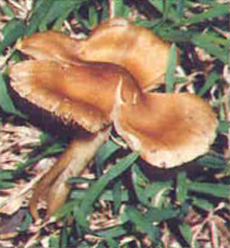- Inocybe aeruginascens
Taxobox
name = Inocybe

image_width = 220px
image_caption = "Inocybe aeruginascens"
regnum =Fungi
divisio =Basidiomycota
classis =Agaricomycetes
ordo =Agaricales
familia =Cortinariaceae
genus = "Inocybe "
species = "Inocybe aeruginascens"
binomial = "Inocybe aeruginascens"
binomial_authority = M. Babos (1968)mycomorphbox
name = Inocybe aeruginascens
whichGills = adnate
whichGills2 = emarginate
capShape = conical
capShape2 = convex
hymeniumType= gills
stipeCharacter= bare
ecologicalType=mycorrhizal
sporePrintColor=tan
howEdible=psychoactive"Inocybe aeruginascens" is a member of the genus "Inocybe" which is widely distributed in Europe. This mushroom species was first documented by J. Ferencz in Osca, Hungary on June 15, 1965 cite web |url=http://www.museocivico.rovereto.tn.it/pubblicazioni.jsp?ID_LINK=111258&area=3 |title=Museo Civico di Rovereto |accessdate= |format= |work=] .
Description
"Inocybe aeruginascens" is a small
mycorrhizal mushroom with aconic toconvex cap which becomes plane in age and is often near the margin. It is usually less than 5cm across, has a slightly darker blunt umbo and an in incurved margin when young. The cap color varies from buff to light yellow brown, usually with greenish stains which disappear when the mushroom dries. The gills are to nearly free, numerous, colored pale brown, grayish brown, or tobacco brown. Thefruiting body has greenish tones and bruises blue where damaged. Thespores are smooth andellipsoid , measuring 6-9.5 x 4.5 micrometres and forming a clay brown spore print. The stem is 2-7 cm long, 3 to 8 mm thick, and is equal width for the whole length, sometimes with some swelling at the base. It is solid, pale grey, becoming bluish green from the bottom up. The stem is fibrous and appears to be covered with fine powder near the top. It has a partial veil which often disappears in age and an unpleasant soapy odor.Distribution and habitat
"Inocybe aeruginascens" is widely distributed in temperate areas and has been reported in central Europe and western North America.
This mushroom grows in moist sandy soils in a mycorrhizal relationship with poplar, linden, oak and willow trees.
Edibility
No
toxicology information exists on Inocybe aeruginascens currently, however a minimum of "23 unintentional intoxications" were reported in 1982 by Drewitz and Babos. Unintentional consumption could be due to the similarity ofMarasmius oreades . The symptoms of "intoxication" were hallucinogenic, leading Gartz and Drewitz to eventually discover the first source ofpsilocybin in any Inocybe species.cite web |url=http://webdoc.sub.gwdg.de/diss/2004/jensen/jensen.pdf |title= Isolation of Aeruginascin from the Hallucinogenic Mushroom Inocybe aeruginascens|accessdate=|format= |work=] There are no known deaths directly related to consumption, however edibility is not yet conclusive.Biochemistry
"Inocybe aeruginascens" contains the formerly known alkaloids
psilocybin ,psilocin ,baeocystin , as well a newly discoveredindoleamine 4-phosphoryloxy-"N,N,N"-trimethyl tryptamine . Jochen Gartz named this new substanceaeruginascin cite web |url=http://www.museocivico.rovereto.tn.it/pubblicazioni.jsp?ID_LINK=111258&area=3 |title=Museo Civico di Rovereto |accessdate= |format= |work=] cite web |url=http://wwwuser.gwdg.de/~ucoc/laatsch/168_Aeruginascin_col.pdf |title= Trimethylammonium Analogue of Psilocybin from the Hallucinogenic Mushroom Inocybe aeruginascens |accessdate= |format= |work=] after the mushroom species. Aeruginascin is the "N"-trimethyl analogue ofpsilocybin . "Inocybe aeruginascens" is the only known natural source of aeruginascin.References
External links
* [http://leda.lycaeum.org/?ID=10410 Extraction and analysis of indole derivatives from fungal biomass]
* [http://leda.lycaeum.org/?ID=10430 New Aspects of the Occurrence, Chemistry, and Cultivation of European Hallucinogen Mushrooms]
Wikimedia Foundation. 2010.
